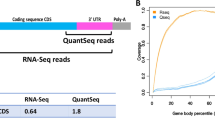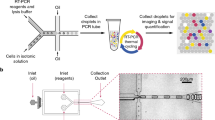Abstract
Analysis of transcript representation on gene microarrays requires microgram amounts of total RNA or DNA. Without amplification, such amounts are obtainable only from millions of cells. However, it may be desirable to determine transcript representation in few or even single cells in aspiration biopsies, rare population subsets isolated by cell sorting or laser capture, or micromanipulated single cells. Nucleic-acid amplification methods could be used in these cases, but it is difficult to amplify different transcripts in a sample without distorting quantitative relationships between them. Linear isothermal RNA amplification has been used to amplify as little as 10 ng of total cellular RNA, corresponding to the amount obtainable from thousands of cells, while still preserving the original abundance relationships1,2. However, the available procedures require multiple steps, are labor intensive and time consuming3, and have not been shown to preserve abundance information from smaller starting amounts. Exponential amplification, on the other hand, is a relatively simple technology, but is generally considered to bias abundance relationships unacceptably2,3,4,5. These constraints have placed beyond current reach the secure and routine application of microarray analysis to single or small numbers of cells. Here we describe results obtained with a rapid and highly optimized global reverse transcription–PCR (RT-PCR) procedure. Contrary to prevalent expectations, the exponential approach preserves abundance relationships through amplification as high as 3 × 1011-fold. Further, it reduces by a million-fold the input amount of RNA needed for microarray analysis, and yields reproducible results from the picogram range of total RNA obtainable from single cells.
This is a preview of subscription content, access via your institution
Access options
Subscribe to this journal
Receive 12 print issues and online access
$209.00 per year
only $17.42 per issue
Buy this article
- Purchase on Springer Link
- Instant access to full article PDF
Prices may be subject to local taxes which are calculated during checkout

Similar content being viewed by others
Change history
19 August 2002
note on SGML, appended PDF, print will be correct (as will final issue PDF)
Notes
*Note: Due to a proofreading error by the authors in the AOP version of the paper, one of the author's names, Carolyn Modi, was spelled incorrectly. This mistake has been corrected in the HTML version and will appear correctly in print. The PDF version available online has been appended.
References
Wang, E., Miller, L.D., Ohnmacht, G.A., Liu, E.T. & Marincola, F.M. High-fidelity mRNA amplification for gene profiling. Nat. Biotechnol. 18, 457–459 (2000).
Baugh, L.R., Hill, A.A., Brown, E.L. & Hunter, C.P. Quantitative analysis of mRNA amplification by in vitro transcription. Nucleic Acids Res. 29, E29/1–9 (2001).
Phillips, J.K. & Lipski, J. Single-cell RT-PCR as a tool to study gene expression in central and peripheral autonomic neurones. Auton. Neurosci. 86, 1–12 (2000).
Freeman, T.C., Lee, K. & Richardson, P.J. Analysis of gene expression in single cells. Curr. Opin. Biotechnol. 10, 579–582 (1999).
Dixon, A.K., Richardson, P.J., Pinnock, R.D. & Lee, K. Gene-expression analysis at the single-cell level. Trends Pharmacol. Sci. 21, 65–70 (2000).
Brady, G., Barbara, M. & Iscove, N.N. Representative in vitro cDNA amplification from individual hemopoietic cells and colonies. Methods Molec. Cell. Biol. 2, 17–25 (1990).
Brady, G. & Iscove, N.N. Methods Enzymol. 225, 611–623 (1993).
Brady, G. Expression profiling of single mammalian cells—small is beautiful. Yeast 17, 211–217 (2000).
Brady, G. et al. Analysis of gene expression in a complex differentiation hierarchy by global amplification of cDNA from single cells. Curr. Biol. 5, 909–922 (1995).
Billia, F., Barbara, M., McEwen, J., Trevisan, M. & Iscove, N.N. Resolution of pluripotential intermediates in murine hematopoietic differentiation by global cDNA amplification from single cells: confirmation of assignments by expression profiling of cytokine receptor transcripts. Blood 97, 2257–2268 (2001).
Brail, L.H. et al. Gene expression in individual cells: analysis using global single cell reverse transcription polymerase chain reaction (GSC RT-PCR). Mutat. Res. 406, 45–54 (1999).
Cano-Gauci, D.F. et al. In vitro cDNA amplification from individual intestinal crypts: a novel approach to the study of differential gene expression along the crypt-villus axis. Exp. Cell Res. 208, 344–349 (1993).
Trumper, L.H. et al. Single-cell analysis of Reed-Sternberg cells: molecular heterogeneity of gene expression and p53 mutations. Blood 81, 3097–3115 (1993).
Robertson, S.M., Kennedy, M., Shannon, J.M. & Keller, G. A transitional stage in the commitment of mesoderm to hematopoiesis requiring the transcription factor SCL/tal-1. Development 127, 2447–2459 (2000).
Al-Taher, A., Bashein, A., Nolan, T., Hollingsworth, M. & Brady, G. Global cDNA amplification combined with real-time RT-PCR: accurate quantification of multiple human potassium channel genes at the single cell level. Yeast 17, 201–210 (2000).
Liu, F., Malaval, L., Gupta, A.K. & Aubin, J.E. Simultaneous detection of multiple bone-related mRNAs and protein expression during osteoblast differentiation: polymerase chain reaction and immunocytochemical studies at the single cell level. Dev. Biol. 166, 220–234 (1994).
Aubin, J.E., Liu, F., Malaval, L. & Gupta, A. Quantitative polymerase chain reaction (PCR): potential applications of poly(A) PCR on samples of limited cell number. Calcif. Tissue Int. 56, S54–S56 (1995).
Candeliere, G.A., Rao, Y., Floh, A., Sandler, S.D. & Aubin, J.E. cDNA fingerprinting of osteoprogenitor cells to isolate differentiation stage-specific genes. Nucleic Acids Res. 27, 1079–1083 (1999).
Dulac, C. & Axel, R. A novel family of genes encoding putative pheromone receptors in mammals. Cell 83, 195–206 (1995).
Acknowledgements
We thank D. Nallainathan for technical assistance, P. Macgregor and M. Albert for their assistance with the linear amplification protocols, C. Holness and colleagues at SyStemix Inc. for DNA sequencing, and P. Subarsky for helpful discussion and advice. This work was supported by an operating grant to N.N.I. from the National Cancer Institute of Canada, and to N.W. from the Ontario Research and Development Challenge Fund.
Author information
Authors and Affiliations
Corresponding author
Ethics declarations
Competing interests
The authors declare no competing financial interests.
Rights and permissions
About this article
Cite this article
Iscove, N., Barbara, M., Gu, M. et al. Representation is faithfully preserved in global cDNA amplified exponentially from sub-picogram quantities of mRNA. Nat Biotechnol 20, 940–943 (2002). https://doi.org/10.1038/nbt729
Received:
Accepted:
Published:
Issue Date:
DOI: https://doi.org/10.1038/nbt729
This article is cited by
-
Single cell sequencing: a distinct new field
Clinical and Translational Medicine (2017)
-
Pre-amplification in the context of high-throughput qPCR gene expression experiment
BMC Molecular Biology (2015)
-
Epigenomic Reprogramming of Adult Cardiomyocyte-Derived Cardiac Progenitor Cells
Scientific Reports (2015)
-
Single prokaryotic cell isolation and total transcript amplification protocol for transcriptomic analysis
Nature Protocols (2015)
-
Isothermal cycling and cascade signal amplification strategy for ultrasensitive colorimetric detection of nucleic acids
Microchimica Acta (2015)



